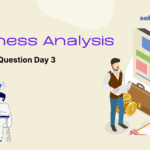Welcome back to Day 2 of our series dedicated to helping you excel in data analyst interviews! Today, we’re diving deeper into technical interview questions, advanced data analysis techniques, and even exploring real-world case studies. Let’s equip you with the knowledge and confidence to ace your upcoming interviews.
Question: Can you explain the difference between a DataFrame and a Series in Python’s pandas library?
Answer: In pandas, a Data Frame is a 2-dimensional labelled data structure with rows and columns, similar to a spreadsheet or SQL table. A Series, on the other hand, is a one-dimensional labelled array that can hold any data type. Data Frames are composed of multiple Series objects, with each column representing a Series.
Question: What are some common methods for handling missing data in a dataset?
Answer: Common methods for handling missing data include removing rows or columns with missing values, imputing missing values using statistical measures such as mean, median, or mode, and using advanced techniques like interpolation or predictive modeling to estimate missing values based on existing data.
Question: How would you detect multicollinearity in a regression analysis?
Answer: Multicollinearity occurs when independent variables in a regression model are highly correlated with each other. To detect multicollinearity, one can calculate the variance inflation factor (VIF) for each independent variable. A high VIF value (> 10) indicates that the variable may be highly correlated with other variables in the model.
Question: Explain the concept of overfitting in machine learning models. How can it be prevented?
Answer: Overfitting occurs when a model learns to capture noise or random fluctuations in the training data, leading to poor performance on unseen data. To prevent overfitting, techniques such as cross-validation, regularization (e.g., L1 and L2 regularization), and using simpler models with fewer parameters can be employed.
Question: What is the purpose of a SQL JOIN statement, and what are its different types?
Answer: A SQL JOIN statement is used to combine rows from two or more tables based on a related column between them. The different types of JOINs include INNER JOIN (returns rows that have matching values in both tables), LEFT JOIN (returns all rows from the left table and matching rows from the right table), RIGHT JOIN (returns all rows from the right table and matching rows from the left table), and FULL JOIN (returns all rows when there is a match in either table).
Question: How do you assess the significance of a correlation coefficient?
Answer: The significance of a correlation coefficient can be assessed using hypothesis testing. Typically, this involves calculating the p-value associated with the correlation coefficient. A small p-value (< 0.05) indicates that the correlation is statistically significant, suggesting a non-random relationship between the variables.
Question: Describe the process of feature selection in machine learning?
Answer: Feature selection involves identifying and selecting the most relevant features from a dataset to improve model performance and reduce dimensionality. This can be done using techniques such as filter methods (e.g., correlation analysis), wrapper methods (e.g., recursive feature elimination), or embedded methods (e.g., regularization).
Question: What are the key components of a hypothesis test, and how do you interpret the results?
Answer: The key components of a hypothesis test include the null hypothesis (H0), alternative hypothesis (H1), test statistic, significance level (alpha), and p-value. If the p-value is less than the significance level, we reject the null hypothesis, indicating that there is sufficient evidence to support the alternative hypothesis.
Question: How would you approach time series analysis to forecast future sales for a retail company?
Answer: I would start by visualizing historical sales data to identify trends, seasonality, and any underlying patterns. Then, I would apply time series forecasting techniques such as ARIMA (AutoRegressive Integrated Moving Average) or exponential smoothing methods to model the data and make predictions for future sales.
Use Case Questions:
Question: You’re analysing customer churn data for a subscription-based service. How would you identify factors influencing churn and develop strategies to reduce it?
Answer: To identify factors influencing churn, I would analyze historical customer data, including demographics, usage patterns, and interactions with the service. Using techniques such as logistic regression or decision trees, I would identify significant predictors of churn. Based on these insights, I would recommend targeted retention strategies such as personalized incentives, improved customer support, or product feature enhancements to reduce churn rates.
Question: Imagine you’re analysing website traffic data for an e-commerce platform. How would you optimize conversion rates and increase sales?
Answer: To optimize conversion rates, I would analyse website traffic patterns, user behaviour, and conversion funnel metrics. Using techniques such as A/B testing or multivariate testing, I would experiment with different website designs, call-to-action buttons, or promotional offers to identify factors that drive conversions. Additionally, I would leverage data-driven marketing strategies such as personalized recommendations, targeted email campaigns, and social media advertising to attract and retain customers, ultimately increasing sales and revenue.










